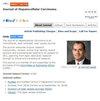CXCL9过表达可预测HCC对抗PD-1疗法的反应并促进中性粒细胞的N1极化
IF 4.2
3区 医学
Q2 ONCOLOGY
引用次数: 0
摘要
背景:抗程序性死亡-1(PD1)抗体改变了肝细胞癌(HCC)的治疗格局,并显示出良好的疗效。然而,大多数肝细胞癌仍然对抗PD-1疗法没有反应:我们分析了接受抗PD-1治疗的患者血液样本中CXCL9的表达,并评估了其与临床病理特征和治疗结果的相关性。利用 qRT-PCR 和多重免疫荧光检测法分别分析了体外和肿瘤样本中 N1 型中性粒细胞的比例:结果:该提名图在训练组和验证组中显示出良好的预测效果,可用于指导 HCC 患者的临床治疗。我们还发现,HCC 细胞衍生的 CXCL9 在体外促进了中性粒细胞的 N1 极化,而特异性 CXCR3 抑制剂 AMG487 能显著阻断这一过程。此外,多重免疫荧光(mIF)显示,血清中CXCL9水平较高的患者,其肿瘤相关中性粒细胞(TANs)的N1表型浸润程度更高:我们的研究强调了CXCL9作为免疫疗法疗效的有效生物标志物以及在促进N1型中性粒细胞极化方面的关键作用;因此,以CXCL9-CXCR3轴为靶点可能是加强HCC免疫疗法的一种新型药物策略。本文章由计算机程序翻译,如有差异,请以英文原文为准。
CXCL9 Overexpression Predicts Better HCC Response to Anti-PD-1 Therapy and Promotes N1 Polarization of Neutrophils
Background: Anti-programmed death-1 (PD1) antibodies have changed the treatment landscape for hepatocellular carcinoma (HCC) and exhibit promising treatment efficacy. However, the majority of HCCs still do not respond to anti-PD-1 therapy.
Methods: We analyzed the expression of CXCL9 in blood samples from patients who received anti-PD-1 therapy and evaluated its correlation with clinicopathological characteristics and treatment outcomes. Based on the results of Cox regression analysis, a nomogram was established for predicting HCC response to anti-PD-1 therapy. qRT‒PCR and multiple immunofluorescence assays were utilized to analyze the proportions of N1-type neutrophils in vitro and in tumor samples, respectively.
Results: The nomogram showed good predictive efficacy in the training and validation cohorts and may be useful for guiding clinical treatment of HCC patients. We also found that HCC cell-derived CXCL9 promoted N1 polarization of neutrophils in vitro and that AMG487, a specific CXCR3 inhibitor, significantly blocked this process. Moreover, multiple immunofluorescence (mIF) showed that patients with higher serum CXCL9 levels had greater infiltration of the N1 phenotype of tumor-associated neutrophils (TANs).
Conclusion: Our study highlights the critical role of CXCL9 as an effective biomarker of immunotherapy efficacy and in promoting the polarization of N1-type neutrophils; thus, targeting the CXCL9-CXCR3 axis could represent a novel pharmaceutical strategy to enhance immunotherapy for HCC.
Methods: We analyzed the expression of CXCL9 in blood samples from patients who received anti-PD-1 therapy and evaluated its correlation with clinicopathological characteristics and treatment outcomes. Based on the results of Cox regression analysis, a nomogram was established for predicting HCC response to anti-PD-1 therapy. qRT‒PCR and multiple immunofluorescence assays were utilized to analyze the proportions of N1-type neutrophils in vitro and in tumor samples, respectively.
Results: The nomogram showed good predictive efficacy in the training and validation cohorts and may be useful for guiding clinical treatment of HCC patients. We also found that HCC cell-derived CXCL9 promoted N1 polarization of neutrophils in vitro and that AMG487, a specific CXCR3 inhibitor, significantly blocked this process. Moreover, multiple immunofluorescence (mIF) showed that patients with higher serum CXCL9 levels had greater infiltration of the N1 phenotype of tumor-associated neutrophils (TANs).
Conclusion: Our study highlights the critical role of CXCL9 as an effective biomarker of immunotherapy efficacy and in promoting the polarization of N1-type neutrophils; thus, targeting the CXCL9-CXCR3 axis could represent a novel pharmaceutical strategy to enhance immunotherapy for HCC.
求助全文
通过发布文献求助,成功后即可免费获取论文全文。
去求助

 求助内容:
求助内容: 应助结果提醒方式:
应助结果提醒方式:


